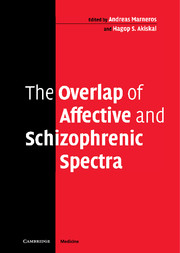Book contents
- Frontmatter
- Contents
- List of contributors
- Preface
- 1 The paradigma of overlapping affective and schizophrenic spectra: schizoaffective conditions
- 2 The overlapping of the spectra: overlapping genes and genetic models
- 3 The continuum of psychosis and its genetic basis
- 4 Functional psychoses: molecular-genetic evidence for a continuum
- 5 State- and trait-related deficits in sustained attention in bipolar disorder: are there any overlaps with schizophrenia?
- 6 The concept of schizoaffective disorder: utility versus validity and reliability – a transcultural perspective
- 7 Phenomenological approaches to the schizoaffective spectrum
- 8 Clinical course of schizoaffective disorders
- 9 Depressive syndromes in schizophrenia
- 10 The overlapping of the spectra: brief and acute psychoses
- 11 Overlapping of the spectra: physical comorbidity between schizophrenia and affective disorders
- 12 The overlapping of the spectra suicide
- 13 Biological treatment of schizoaffective disorders
- 14 Psychological therapies and schizoaffective disorders
- Epilogue: The interface of affective and schizophrenic disorders: a cross between two spectra?
- Index
1 - The paradigma of overlapping affective and schizophrenic spectra: schizoaffective conditions
Published online by Cambridge University Press: 02 September 2009
- Frontmatter
- Contents
- List of contributors
- Preface
- 1 The paradigma of overlapping affective and schizophrenic spectra: schizoaffective conditions
- 2 The overlapping of the spectra: overlapping genes and genetic models
- 3 The continuum of psychosis and its genetic basis
- 4 Functional psychoses: molecular-genetic evidence for a continuum
- 5 State- and trait-related deficits in sustained attention in bipolar disorder: are there any overlaps with schizophrenia?
- 6 The concept of schizoaffective disorder: utility versus validity and reliability – a transcultural perspective
- 7 Phenomenological approaches to the schizoaffective spectrum
- 8 Clinical course of schizoaffective disorders
- 9 Depressive syndromes in schizophrenia
- 10 The overlapping of the spectra: brief and acute psychoses
- 11 Overlapping of the spectra: physical comorbidity between schizophrenia and affective disorders
- 12 The overlapping of the spectra suicide
- 13 Biological treatment of schizoaffective disorders
- 14 Psychological therapies and schizoaffective disorders
- Epilogue: The interface of affective and schizophrenic disorders: a cross between two spectra?
- Index
Summary
Broad–narrow–broad: the circuitry of certainties and uncertainties
In the centuries between the great Greek founders of medicine and psychiatry, Hippocrates, Aretaeus of Cappadocia, Galenos of Pergamon or Soranos of Ephesos (see Longrigg, 1993; Marneros and Angst, 2000; Angst and Marneros, 2001) and the father of the modern psychiatric systematics, Emil Kraepelin, at the end of the nineteenth and the beginning of the twentieth century, physicians and psychiatrists described and allocated mental disorders according to broad criteria. Symptoms, which today in modern nomenclature are called “schizophrenic,” “affective,” “mood congruent” or “mood-incongruent,” were described as characteristics of the same disorder. Therefore, case reports published during this long historic period of more than 2400 years could, with the same strong arguments, be interpreted by modern psychiatrics as “pure schizophrenia,” or “pure affective disorder” or “typical schizoaffective.” At the end of the nineteenth century, Emil Kraepelin tried to clean the field, dichotomizing the so-called functional psychotic disorders into dementia praecox and manic-depressive illness (Kraepelin, 1896; 1899). The Kraepelinian dichotomy, which really was not very dichotomous, as Emil Kraepelin himself pointed out in 1920, received an epigonal strength by Kurt Schneider (1959) through the definition of “first-rank schizophrenic symptoms”: their existence confirms the diagnosis “schizophrenia” (provided that organic causal conditions can be ruled out). Kurt Schneider's ascetic strength completed in some way Karl Jaspers' hierarchical principle (1913).
- Type
- Chapter
- Information
- The Overlap of Affective and Schizophrenic Spectra , pp. 1 - 24Publisher: Cambridge University PressPrint publication year: 2006



